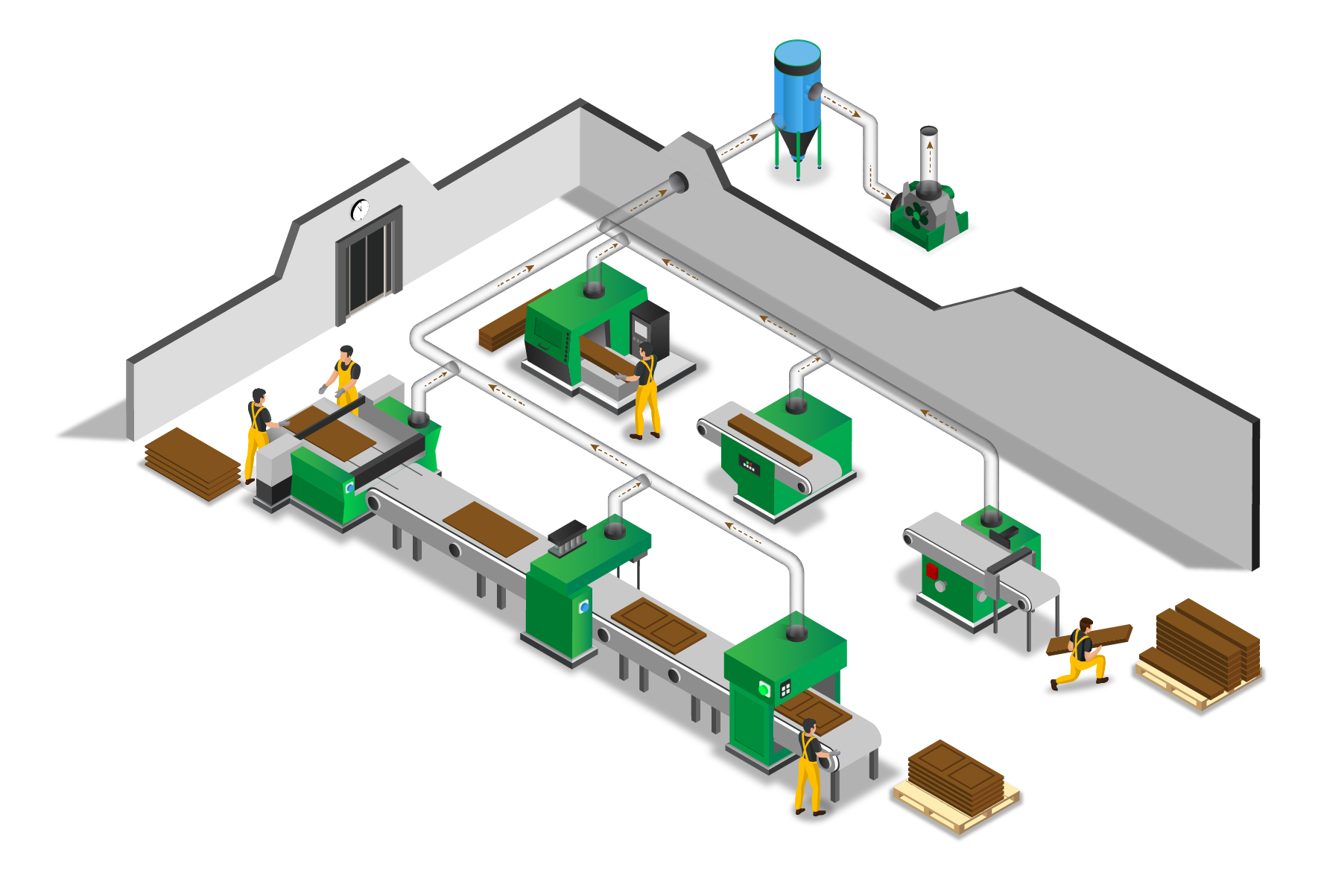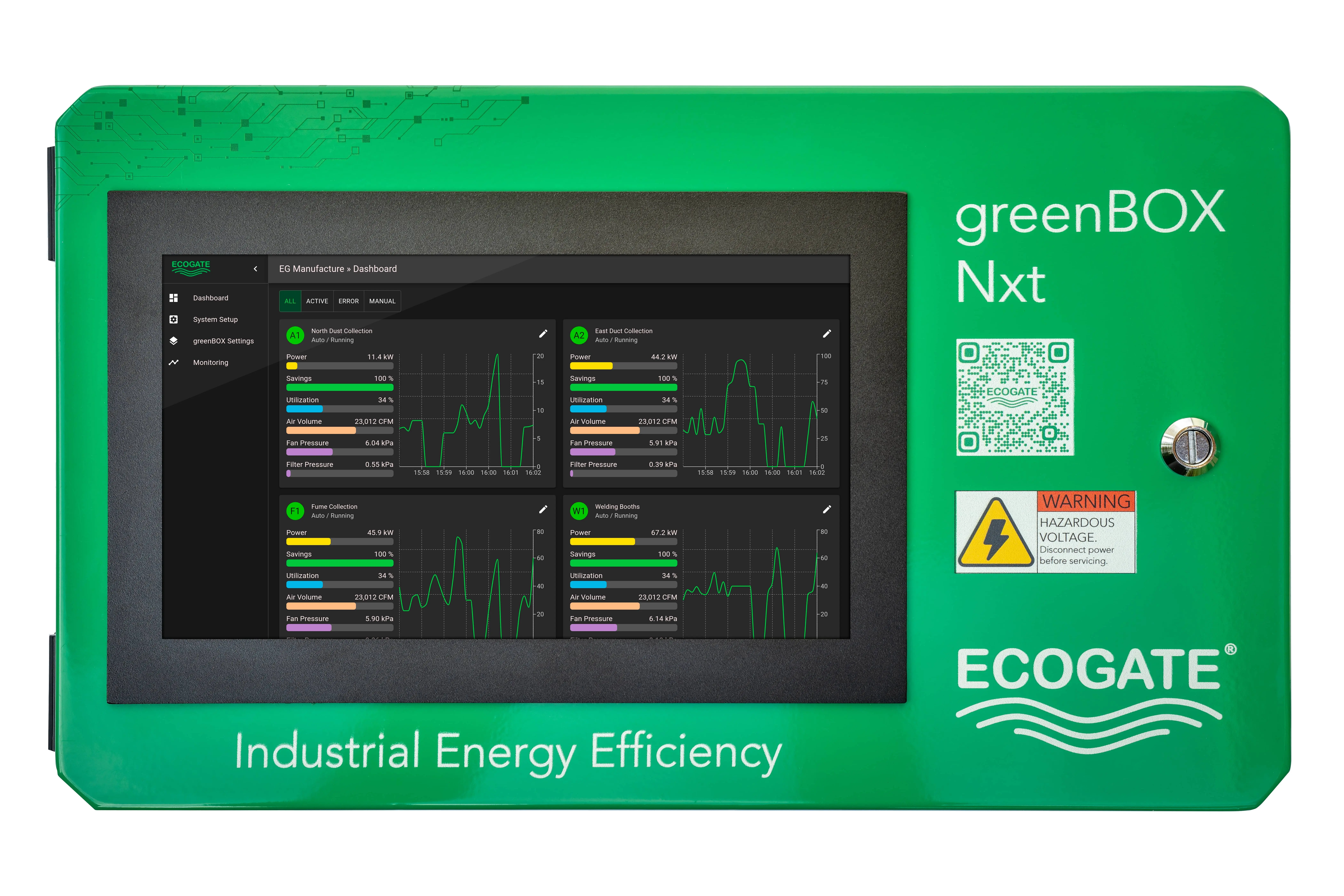“Why Can’t I Just Install a Fan VFD To Save Electricity?”
A Closer Look at the Common Misconception
Have you ever wondered, “Why can't I just install a dust collection VFD to save energy?” It sounds simple enough, right? But as many factory managers and operators find out, slowing down the fan with a VFD (Variable Frequency Drive) is just the tip of the iceberg.
We’ll cover two reasons a VFD is used with a dust collecting system (as a soft-start or to adjust system performance). We’ll also unpack the reasons why using a VFD alone without an intelligent on-demand system will NOT save you energy.
Reason 1: Using a VFD as a Fan Soft-Start
The first benefit of installing a VFD is that it serves as the best fan soft-start option. When a fan or motor starts–with a direct connection to a 3-phase supply–the starting current can be up to 12 times the normal current. This can increase your power peak demand, resulting in higher charges from power companies. You can try using a soft-start unit, which reduces the motor voltage for a few seconds after the fan starts, reducing the starting current to about 8 times the normal motor current. This, however, is still not ideal!
The VFD, on the other hand, gently changes the motor frequency during the start ramp while keeping the motor current under normal running current. This means no peak power and no additional charges by the power company. Additionally, a gentle start reduces wear and tear on the motor and fan, increasing their lifespan.
Reason 2: Adjusting Dust Collecting System’s Performance
When a VFD is not accompanied by an intelligent on-demand control system, it can still be utilized to adjust fan performance. For example, if your system's designed air volume is 30,000 CFM, but your fan is providing 55,000 CFM at full speed, the VFD can be used to calibrate the fan's performance to the intended 30,000 CFM. This is generally similar to changing the motor/fan's gear ratio.
However, it's important to note that such adjustments should be done by an industrial ventilation expert. They must carefully check the duct and drop air velocities, as slowing down the fan will cause a decrease in fan pressure. This reduced pressure must still be sufficient to cover the entire dust collecting pressure losses (hoods, ducting, non-return valves, filters, abort gates, and return air).
The VFD can also be used to run the fan over its maximal speed, exceeding 60 Hz. Again, this adjustment requires an expert's touch. The fan manufacturer must confirm the maximum safe speed of the fan, and there must be a reserve in VFD power, motor power, disconnect power, and cable current. Keep in mind that with increased motor RPM, the motor power increases with a cubic function, meaning it rises very quickly.
In both scenarios, the VFD offers versatile control but requires careful handling and expert oversight to ensure optimal and safe performance.
Using the VFD To Save Electricity

Installing a VFD can be used to slow down the fan, and yes, it will reduce energy use. However, this comes with a major drawback: it will decrease the air volume and suction at all drops, and air velocity in the duct system. A VFD without an on-demand control system cannot be used to reduce electricity use, it can be only used to adjust system performance as we explained in the previous section.
To decrease electricity consumption you need an intelligent On-Demand Dust Collection System equipped with automatic gates at all workstations, workstation activity sensors, a smart control unit, and - yes! - a VFD. Let's unpack this type of system and how each component is needed to achieve the goal of saving electricity on your industrial ventilation system.
A High-Level View of a Dust Collection System
To fully grasp the situation, let's being with a high-level overview of a typical dust collection system:

Let's take as a given that the system is impeccably designed and that, with the fan at full speed, every workstation experiences optimal suction. While reality will definitely challenge this ideal—machines get relocated, additions are made, and performance can degrade over time—in the context of this article, we'll operate under the assumption that we're examining a well-designed system in prime condition.
Understanding the Affinity Laws (or the “Fan Laws”) helps us understand the relationship between fan power and air volume.

When the system is running at full throttle, we find ourselves at the top-right corner of the graph, where fan power and air volume are both at 100%. By slowing down the fan with a VFD, our operating point shifts downward and left along the curve. It's a logical shift; there's simply no way to decrease the fan's power without a corresponding reduction in air volume.
A Smart Solution: Intelligent Air Flow Management
The good news? There’s an intelligent way to reduce the total system air volume without compromising system performance or safety.
Most factories don’t need dust, fumes, or mist extraction for all machines at the same time. Here’s a representative example (showing real data from a US-based furniture manufacturer) of how much different workstations are used:

Most of the time, the total air volume needed by the entire system is substantially less than the designed air volume – that is, the volume required when every workstation needs simultaneous suction.
This represents a huge opportunity for you to convert your system into an On-Demand Dust Collection System. Let’s unpack the components of such system that'll help you reduce the total system air volume without compromising your system's performance!
Automatic Blast Gates
First, we’ll need to install blast gates (dampers) at each workstation or drop to give us airflow control. The question becomes, should you install automatic blast gates or manual blast gates? Think of manual gates as manual windows in your car - they’re tedious to operate and why would you have those in 2023?! Manual gates are much cheaper but have significant drawbacks making them a terrible option for most applications:
Manual gates demand an operator's constant attention to open and close them, diverting time and focus from their primary responsibilities. In reality, these gates are rarely operated as intended; we have yet to encounter a factory where manual gates are consistently used according to design.
Manual blast gates are not integrated with the rest of the system. The VFD remains unaware of which gates are open or closed, unable to adjust the fan accordingly. This disconnection can lead to problems like ducting collapse or material settling within the ducting.
Sensors

With automatic blast gates you’ll need a way to determine which gates should be open and which should remain closed. Workstation Activity Sensors allow us to automate this in real-time. They detect when a machine needs suction and which ones don’t. We have several sensor options that allow us to cater to the unique needs of each machine.
However, even with automatic blast gates and workstation activity sensors in place, challenges remain. There are some situations where having only gates and sensors installed can lead to compromised performance or system collapse.
Ecogate’s greenBOX Control System

The last component is to incorporate intelligence into the process. To successfully reduce electricity consumption without compromising performance or safety, you need a smart controller. The greenBOX Controller has complete awareness of your industrial dust collection system’s operations and knows precisely how to respond in every scenario.
Additionally, you also need to ensure you maintain minimum transport air velocities throughout your entire ducting system. Failure to do so, results in dust settling in your ducts - which as we know, contributes to factory fires and explosions. The greenBOX does this for you efficiently and automatically.
On-Demand Dust Collection
This level of automation and smart controls is called On-Demand Dust Collection and there’s no one better at this than Ecogate. Our system completely automates your dust collection system, improving its performance and efficiency, all while reducing your electricity usage by more than 50% (the average savings is 68%). At the end of the day, your workers should be focused on their work, not on managing dust collection systems.
Here's a glance at the Ecogate System:

Ready to Transform Your Dust Collection System?
Ecogate's smart solution ensures optimal performance, energy efficiency, and safety. If you're ready to take the next step in saving electricity, contact us. Our experts are here to guide you towards a tailored solution. Bring your company into the future by making your system an On-Demand Dust Collection system.
Author, David Vera & Ales Litomisky













